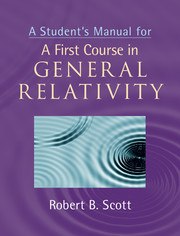Refine listing
Actions for selected content:
17002 results
4 - Perfect fluids in special relativity
-
- Book:
- A Student's Manual for <I>A First Course in General Relativity</I>
- Published online:
- 18 December 2015
- Print publication:
- 21 January 2016, pp 76-97
-
- Chapter
- Export citation
11 - Schwarzschild geometry and black holes
-
- Book:
- A Student's Manual for <I>A First Course in General Relativity</I>
- Published online:
- 18 December 2015
- Print publication:
- 21 January 2016, pp 247-267
-
- Chapter
- Export citation
5 - Preface to curvature
-
- Book:
- A Student's Manual for <I>A First Course in General Relativity</I>
- Published online:
- 18 December 2015
- Print publication:
- 21 January 2016, pp 98-120
-
- Chapter
- Export citation
10 - Spherical solutions for stars
-
- Book:
- A Student's Manual for <I>A First Course in General Relativity</I>
- Published online:
- 18 December 2015
- Print publication:
- 21 January 2016, pp 227-246
-
- Chapter
- Export citation
12 - Cosmology
-
- Book:
- A Student's Manual for <I>A First Course in General Relativity</I>
- Published online:
- 18 December 2015
- Print publication:
- 21 January 2016, pp 268-292
-
- Chapter
- Export citation
References
-
- Book:
- A Student's Manual for <I>A First Course in General Relativity</I>
- Published online:
- 18 December 2015
- Print publication:
- 21 January 2016, pp 303-304
-
- Chapter
- Export citation
2 - Vector analysis in special relativity
-
- Book:
- A Student's Manual for <I>A First Course in General Relativity</I>
- Published online:
- 18 December 2015
- Print publication:
- 21 January 2016, pp 23-46
-
- Chapter
- Export citation
1 - Special relativity
-
- Book:
- A Student's Manual for <I>A First Course in General Relativity</I>
- Published online:
- 18 December 2015
- Print publication:
- 21 January 2016, pp 1-22
-
- Chapter
- Export citation
Appendix B - Useful results
-
- Book:
- A Student's Manual for <I>A First Course in General Relativity</I>
- Published online:
- 18 December 2015
- Print publication:
- 21 January 2016, pp 295-302
-
- Chapter
- Export citation
Frontmatter
-
- Book:
- A Student's Manual for <I>A First Course in General Relativity</I>
- Published online:
- 18 December 2015
- Print publication:
- 21 January 2016, pp i-iv
-
- Chapter
- Export citation
6 - Curved manifolds
-
- Book:
- A Student's Manual for <I>A First Course in General Relativity</I>
- Published online:
- 18 December 2015
- Print publication:
- 21 January 2016, pp 121-159
-
- Chapter
- Export citation
9 - Gravitational radiation
-
- Book:
- A Student's Manual for <I>A First Course in General Relativity</I>
- Published online:
- 18 December 2015
- Print publication:
- 21 January 2016, pp 210-226
-
- Chapter
- Export citation
7 - Physics in curved spacetime
-
- Book:
- A Student's Manual for <I>A First Course in General Relativity</I>
- Published online:
- 18 December 2015
- Print publication:
- 21 January 2016, pp 160-185
-
- Chapter
- Export citation
3 - Tensor analysis in special relativity
-
- Book:
- A Student's Manual for <I>A First Course in General Relativity</I>
- Published online:
- 18 December 2015
- Print publication:
- 21 January 2016, pp 47-75
-
- Chapter
- Export citation
Appendix A - Acronyms and definitions
-
- Book:
- A Student's Manual for <I>A First Course in General Relativity</I>
- Published online:
- 18 December 2015
- Print publication:
- 21 January 2016, pp 293-294
-
- Chapter
- Export citation
Contents
-
- Book:
- A Student's Manual for <I>A First Course in General Relativity</I>
- Published online:
- 18 December 2015
- Print publication:
- 21 January 2016, pp v-vi
-
- Chapter
- Export citation
Preface
-
- Book:
- A Student's Manual for <I>A First Course in General Relativity</I>
- Published online:
- 18 December 2015
- Print publication:
- 21 January 2016, pp vii-x
-
- Chapter
- Export citation
8 - The Einstein field equations
-
- Book:
- A Student's Manual for <I>A First Course in General Relativity</I>
- Published online:
- 18 December 2015
- Print publication:
- 21 January 2016, pp 186-209
-
- Chapter
- Export citation

A Student's Manual for A First Course in General Relativity
-
- Published online:
- 18 December 2015
- Print publication:
- 21 January 2016
Contents
-
- Book:
- The Cambridge Double Star Atlas
- Published online:
- 05 May 2016
- Print publication:
- 10 December 2015, pp v-vi
-
- Chapter
- Export citation
